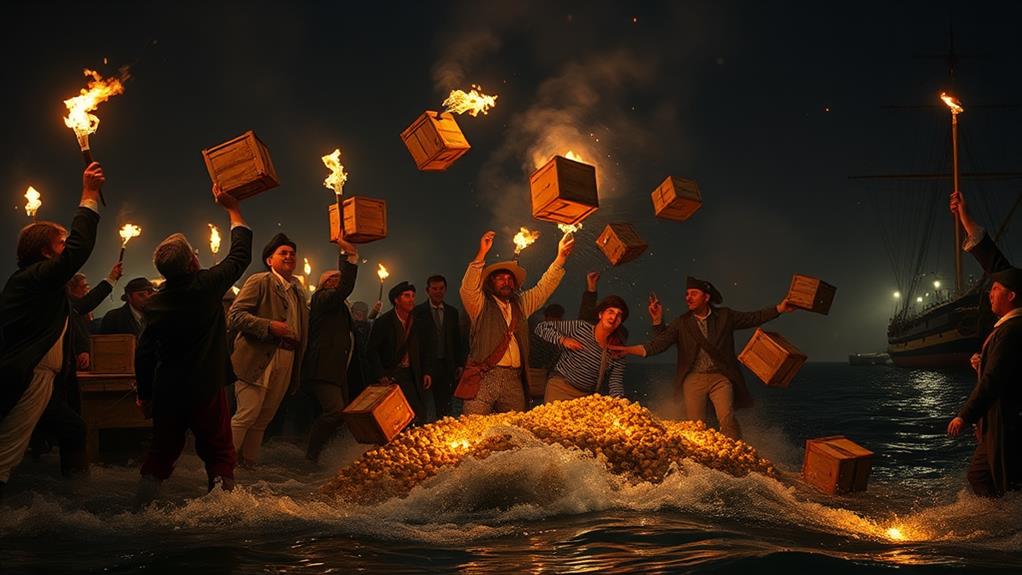The Boston Tea Party was more than just a protest about tea; it was a bold statement against British control. On December 16, 1773, colonists frustrated with taxation without representation disguised themselves and dumped 342 chests of British tea into Boston Harbor. This act sparked unity among the colonies and anger from Britain, leading to harsh penalties known as the Intolerable Acts. Key figures like Samuel Adams rallied others to join the cause, igniting a revolutionary spirit. The Boston Tea Party became a symbol of defiance, setting the stage for future actions in the fight for American independence. Want to know more about its impact?
Historical Context of the Tea Act
As tensions mounted in the American colonies during the late 18th century, the Tea Act of 1773 emerged as a catalyst for unrest. This British policy aimed to boost the struggling tea trade by allowing the British East India Company to sell tea directly to the colonies, bypassing colonial merchants.
However, you can see how this move sparked colonial resistance. Many colonists felt it increased their taxation grievances, as they believed it was yet another way for Britain to impose economic factors without representation.
The act didn't just affect trade; it ignited social unrest among colonists who viewed it as an attack on their rights. Merchant opposition grew, with local businesses fearing they'd be driven out by cheaper British tea.
This discontent led to a surge in political activism, as people began organizing protests and rallies. The Tea Act was more than just about tea; it represented a growing frustration with British policies that disregarded colonial interests.
You can imagine how this atmosphere of agitation set the stage for significant events, like the Boston Tea Party, where colonists took a stand against what they saw as tyranny disguised as trade regulations.
Key Figures Involved
The growing discontent over the Tea Act galvanized a number of key figures who played pivotal roles in the Boston Tea Party and the broader movement for independence.
You'll find that influential leaders like Samuel Adams emerged as passionate advocates for colonial rights, rallying revolutionary activists to rise against British tyranny. These key players understood the economic implications of the Tea Act, recognizing how it threatened the livelihoods of colonial merchants and the very fabric of their economy.
Public sentiment swelled as people became increasingly aware of the political motivations behind the British Parliament's decisions. In response, organized resistance took shape, with groups like the Sons of Liberty leading the charge.
These passionate activists didn't just want to protest; they aimed to inspire others and create a united front against oppression.
Through their actions, these figures created a spark that ignited the flames of revolution. They showed that when ordinary citizens come together for a cause, they can challenge even the mightiest powers.
The Events Leading Up to the Protest
Growing tensions in the colonies laid the groundwork for the Boston Tea Party. As you navigate through the late 1760s, you'll notice a rise in colonial discontent.
British policies imposed heavy taxation on everyday items, including the beloved tea, which wasn't only a popular beverage but also a source of health benefits exceptional health benefits that many colonists cherished. This led to a strong wave of taxation resistance among the colonists, who felt the economic pressures mounting.
Tea consumption was more than just a habit; it held cultural significance, representing comfort and community. Merchant grievances grew, as local businesses struggled under the weight of British control.
They devised protest strategies, uniting against unfair practices. Social tensions escalated as colonists rallied together, spurred by a desire for political mobilization. You can sense the energy in the air as communities discuss their rights and freedoms.
The situation reached a boiling point when the British government granted the East India Company a monopoly on tea sales. This move angered many, as it directly threatened local merchants.
With each new law, the colonists felt more determined to fight back. These events set the stage for a dramatic showdown, where tea would become a symbol of resistance, igniting a fire that no one could ignore.
The Night of the Tea Party
On the evening of December 16, 1773, a sense of urgency filled the air in Boston. You can almost feel the tension as colonists gathered to discuss their protest motivations. The plan was clear: destroy the tea types they felt symbolized British oppression.
Under the cover of darkness, the nighttime atmosphere heightened their resolve. Disguise strategies were crucial; many donned Native American attire to conceal their identities and send a powerful message.
In the planning meetings leading up to this historic event, the colonists shared their frustrations about taxation without representation. They believed this destruction wasn't just about tea; it represented the fight for their rights.
As you watch them board the ships, their hearts pound with excitement and fear. They're not just throwing tea overboard; they're making a statement.
The tea destruction wasn't random; it had deep symbolic significance. Each crate tossed into the harbor was a declaration of independence and unity against tyranny.
As you reflect on that night, you realize it was more than a protest; it was a turning point in the struggle for freedom, igniting a revolutionary spirit that would shape the future.
Reactions From British Authorities
After the Boston Tea Party, British authorities were quick to react, showing just how serious they took the event.
You might be surprised to learn that their immediate government response was intense and set the stage for long-term changes in legislation.
These reactions not only aimed to punish the colonists but also shaped the future of British colonial policy in America.
Immediate Government Response
The Boston Tea Party sparked an immediate and fierce reaction from British authorities. They viewed the act as a direct challenge to their power and authority. In response, the British government quickly devised strategies aimed at quelling colonial grievances and reasserting control.
Here's a glimpse of what unfolded:
| Government Action | Purpose |
|---|---|
| Coercive Acts (Intolerable Acts) | Punish Massachusetts for the Tea Party |
| Closing Boston Harbor | Disrupt trade and economic activities |
| Increased military presence | Intimidate the colonists |
| Restrict town meetings | Limit colonial self-governance |
| Strengthen royal governors | Ensure loyalty to British rule |
These measures aimed to make an example of Massachusetts, hoping to deter other colonies from similar acts of defiance. However, instead of quelling dissent, the government strategies often ignited further unrest, leading to a greater push for unity among the colonies. As you can see, the British response was far from subtle, demonstrating how seriously they took the colonists' actions. The stage was set for escalating tensions, as the colonists rallied against what they saw as oppressive measures.
Long-term Legislative Impact
As British authorities grappled with the fallout from the Boston Tea Party, their efforts to reassert control led to significant long-term legislative changes. In response to the event, they introduced a series of laws with serious legislative repercussions. The Intolerable Acts, for example, tightened trade regulations and aimed to stifle colonial grievances by punishing Massachusetts.
These actions didn't just irritate the colonies; they fueled revolutionary sentiment and sparked political mobilization across the region. You can see how these changes were driven by economic motivations. The British government believed that strict taxation policies would help restore order and revenue.
However, they underestimated the colonists' desire for self-governance. Instead of quelling dissent, these measures intensified debates over governance disputes, pushing more colonists toward the revolutionary cause.
The Boston Tea Party and its aftermath transformed the American landscape, igniting a passion for independence. As you reflect on this pivotal moment, consider how a simple act of defiance against taxation sparked a movement that altered the course of history.
The British response only deepened the resolve of the colonists, setting the stage for a revolution that would change everything.
Impact on Colonial Unity
The Boston Tea Party really brought the colonies together in a way few events had before.
You'd see increased cooperation among the colonists, as they united against British rule and began to form a strong Patriot identity.
This shared experience sparked a sense of belonging and purpose that would eventually fuel the fight for independence.
Increased Colonial Cooperation
Amid growing tensions with Britain, increased colonial cooperation emerged as a vital force in uniting the colonies against shared grievances. You can see this cooperation through various colonial alliances and cooperative strategies that formed during this critical time. Colonies recognized their strength in numbers and began to work together more effectively.
Here are three key ways increased cooperation shaped colonial unity:
- Committees of Correspondence: These groups sprang up across the colonies, sharing information and coordinating responses to British actions. They fostered communication, ensuring everyone was on the same page.
- Boycotts and Protests: By uniting to boycott British goods, colonists demonstrated their collective power. This strategy not only hurt British merchants but also encouraged a sense of shared purpose among the colonies.
- Continental Congress: The formation of this assembly brought representatives from various colonies together to discuss their grievances and strategize. It marked a significant step toward a unified response to British rule.
Through these innovative steps, you can see how increased cooperation laid the groundwork for a stronger, more united front against British oppression, igniting the flames of revolution!
Emergence of Patriot Identity
In the years leading up to the Boston Tea Party, a distinct Patriot identity began to emerge, significantly influencing colonial unity. This new identity wasn't just about resisting British rule; it was about forging a collective identity that united diverse groups within the colonies.
Grassroots movements sprang up, fueled by a revolutionary spirit that resonated deeply among the people. You'd see communities rallying around patriot symbols, like the Liberty Tree, which became powerful icons of resistance.
Cultural expressions, from pamphlets to songs, helped spread this message, fostering ideological unity. People organized themselves, forming committees that strengthened community organization and social cohesion.
Dissenting voices, once isolated, found strength in numbers, creating a chorus of political awareness that echoed throughout the colonies.
As you reflect on this period, consider how these elements combined to spark a passion for independence. The emergence of this Patriot identity not only united colonists but also laid the groundwork for a movement that would change the course of history.
It was a time when the spirit of collaboration flourished, proving that together, they could stand against oppression and demand their rights.
The Role of Propaganda
While many view the Boston Tea Party as a straightforward act of defiance against British taxation, it was also a masterclass in propaganda. The revolutionaries knew how to capture public sentiment and sway opinion. They employed various propaganda techniques to amplify their message and inspire grassroots mobilization.
Here's how they did it:
- Colonial Newspapers: These became a powerful tool for information dissemination, spreading news about the event and framing it as a noble cause.
- Political Cartoons: Artists used vivid imagery to mock British authority, making the struggle relatable and engaging for the average colonist.
- Social Gatherings: Meetings and rallies allowed for direct communication, promoting revolutionary rhetoric and sparking enthusiasm among attendees.
Through word of mouth and media influence, the story of the Boston Tea Party transformed into a symbol of resistance. The colonists painted themselves as heroes fighting against tyranny, creating an emotional connection with their peers.
Legacy of the Boston Tea Party
The Boston Tea Party didn't just serve as a catalyst for rebellion; it left an enduring legacy that shaped American identity and political discourse. You can see its cultural significance in how it sparked social movements aimed at challenging authority. This bold act of resistance became a symbol of defiance against unjust taxation, influencing how Americans viewed their rights and responsibilities.
The tea trade, once a staple of commerce, transformed into a battleground for political symbolism. Economically, the Boston Tea Party had lasting ramifications. By disrupting the tea trade, colonists sent a clear message about their willingness to stand against oppression. This act also helped frame historical narratives that would be told for generations, embedding the event deeply in public memory.
It showcased innovative resistance strategies, inspiring future activists to think outside the box. Even today, the Boston Tea Party resonates in discussions about justice and equality. It reminds us that ordinary citizens can shake up the status quo.
As you reflect on this legacy, consider how the spirit of the Tea Party still fuels movements advocating for change, proving that the fight against injustice is as relevant now as it was back then.
Connection to the American Revolution
The Boston Tea Party played a pivotal role in igniting the American Revolution by uniting colonists in their defiance against British rule. It wasn't just about tea; it sparked a larger movement of colonial resistance. This event showcased the colonists' economic grievances against the British, leading to a political awakening that transformed ordinary citizens into passionate activists.
Here are three key connections:
- Symbolic Protest: The act of dumping tea into Boston Harbor became a powerful symbol of resistance against British arrogance and control.
- Grassroots Mobilization: Colonists organized and rallied together, proving that collective action could challenge a formidable empire.
- Consumer Boycotts: Following the Tea Party, boycotts of British goods intensified, demonstrating the impact of economic strategies in seeking independence.
Tea symbolism was everywhere, reminding people of their struggle for freedom. It wasn't just a fun event; it was a clarion call for change.
You could feel the energy in the air as colonists began to realize their strength. This grassroots momentum ultimately paved the way for the revolutionary spirit that would lead to the birth of a new nation.
FAQ
What Types of Tea Were Dumped During the Boston Tea Party?
During the Boston Tea Party, you'd find a mix of tea varieties like green, black, and even herbal options. The colonial preferences leaned towards strong flavors, reflecting their desire for unique, bold experiences in tea consumption.
How Did the Boston Tea Party Influence Modern Protests?
Did you know that 70% of modern protests incorporate civil disobedience? The Boston Tea Party inspired innovative protest tactics, showing you that collective action can challenge authority, spark change, and resonate through history.
Were There Any Injuries During the Boston Tea Party?
During the event, there aren't significant injury reports, as protest tactics focused on property damage rather than violence. You'll find that innovative approaches can spark change while minimizing harm to individuals involved.
What Other Methods Did Colonists Use to Resist British Taxation?
You'll find colonists employed various innovative methods to resist British taxation, including strategic boycott tactics that undermined trade and mobilizing colonial assemblies to voice discontent, fostering unity and creativity in their quest for independence.
How Did the Boston Tea Party Affect Tea Consumption in America?
Imagine a garden, once flourishing with colonial tea, suddenly choked by weeds. After the Boston Tea Party, Americans shifted their consumption habits, embracing herbal brews and local alternatives, revitalizing their tea culture into something uniquely innovative.
Final Thoughts
The Boston Tea Party was a bold act of defiance that rallied colonists against British rule. Did you know that about 342 chests of tea were dumped into Boston Harbor, worth over a million dollars today? This event not only sparked outrage in Britain but also united the colonies in their fight for freedom. The legacy of this daring protest continues to inspire movements for justice around the world, reminding us all that even a cup of tea can stir up change!



